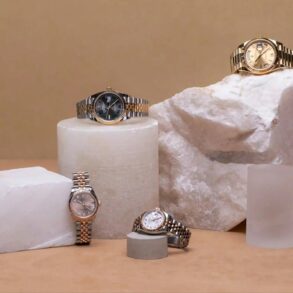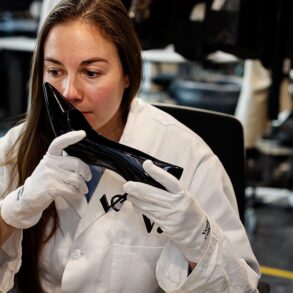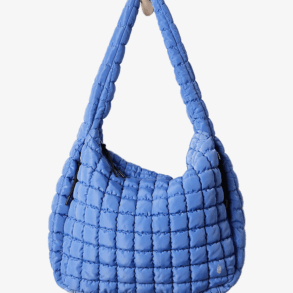
By the end of the year, you may be able to purchase a one-of-a-kind fashion accessory—a handbag made from “T. rex leather”! If successful, this “next-gen material” will be a lab-grown, leatherlike material made from “ancient protein sequences.” How is this possible? Well, it’s only (potentially) possible because T. rex fossils aren’t millions of years old!
You see, in a landmark 2005 study, soft tissue was discovered in a T. rex femur. Since that first popularized discovery, soft tissue has been found in a wide variety of fossils ranging from evolutionary ages of tens of millions to even hundreds of millions of years. The presence of this soft tissue is a big problem for the evolutionary timeline—but more on that later.
The companies working together to make this “leather” plan to use fossilized dinosaur collagen (a protein found in skin) “as a template” to “generate a complete collagen sequence for the T-Rex to cultivate new skin. The collagen sequence will be translated into DNA and introduced into Lab-Grown Leather’s cells.”
Here’s how the CEO of one of the companies involved described the project:
This project is a remarkable example of how we can harness cutting-edge genome and protein engineering to create entirely new materials. By reconstructing and optimizing ancient protein sequences, we can design T. Rex leather, a biomaterial inspired by prehistoric biology, and clone it into a custom-engineered cell line.
It will be interesting to see if they’re successful in their endeavors—and if the handbags will be for sale and what the price will be! Dr. Georgia Purdom, our Director of Research and VP of Educational Content, who has a PhD in molecular genetics, is skeptical that the methodology they’re employing will result in a realistic T. rex “leather”:
“Back sequencing” from proteins to DNA, while plausible in theory, has some serious constraints. Proteins are made when the code in the DNA is transcribed into messenger RNA (mRNA). The mRNA is then translated into the amino acid sequence which composes the protein. There are 2–6 possible codons in the mRNA for most amino acids. Knowing the amino acid in the protein doesn’t tell you which of those codons was used in the mRNA (and by correlation the code in the DNA). Many research studies have shown that the codon used for the amino acid is important. Sometimes a particular codon can cause the protein to pause during translation so that proper folding of the protein can occur. The structure of the protein is very important for its proper function. DNA is loaded with layers upon layers of information that are necessary for the appropriate formation of proteins because it is designed by God and not the result of random chance mutations over eons of time. I remain highly skeptical that this project will result in functional T. rex protein.
Now I said earlier that soft tissue is a big problem in the evolutionary worldview because it simply can’t last millions of years. The article on the coming handbag mentions this problem:
While it was previously believed that dinosaur DNA wouldn’t survive for millions of years, recent discoveries have found collagen preserved in various dinosaur fossils, including an 80-million-year-old T Rex.
In other words, soft tissue shouldn’t be able to last millions of years—but we have it, so it must have . . . somehow! So there must be a mechanism to make it last even though they don’t know what it is. In other words, no matter what they find they will come up with a rescuing device to try to justify their position. Now it’s highly questionable whether intact DNA has been found in any dinosaur fossils, but protein (which also shouldn’t be able to last millions of years) has definitely been found.
The article then states, “Last year, MIT researchers decoded how the dinosaur collagen survived for so long” . . . but did they?
Well, no, they haven’t. Just like previous attempts to explain how soft tissue could last that long, this new study also had problems such as not accounting for the real-world conditions fossils are found in—an important consideration!
Under the right conditions, it’s not that difficult to explain how soft tissue can last just a few thousand years.
If these researchers can create T. rex “leather” in the lab, they can only do so because of the global flood that rapidly buried billions of creatures, preserving them—sometimes including soft tissue—for only thousands of years.
Get More Answers on Answers News
This item was discussed Monday on Answers News with cohosts Bryan Osborne, Rob Webb, and Jessica DeFord. Answers News is our weekly news program filmed live before a studio audience here at the Creation Museum, broadcast on our Answers in Genesis YouTube channel, and posted to Answers TV. We also covered the following topics:
- Abortion pill complications far higher than reported.
- Will a “baby bonus” reverse declining birth rates?
- Does our DNA “evolve” faster than thought?
- And more!
Watch the entire episode of Answers News for May 5, 2025.
Be sure to join us each Monday at 2 p.m. (ET) on YouTube or later that day on Answers TV for Answers News. You won’t want to miss this unique news program that gives science and culture news from a distinctly biblical and Christian perspective.
Thanks for stopping by and thanks for praying,
Ken
This item was written with the assistance of AiG’s research team.
This post was originally published on this site be sure to check out more of their content.



































